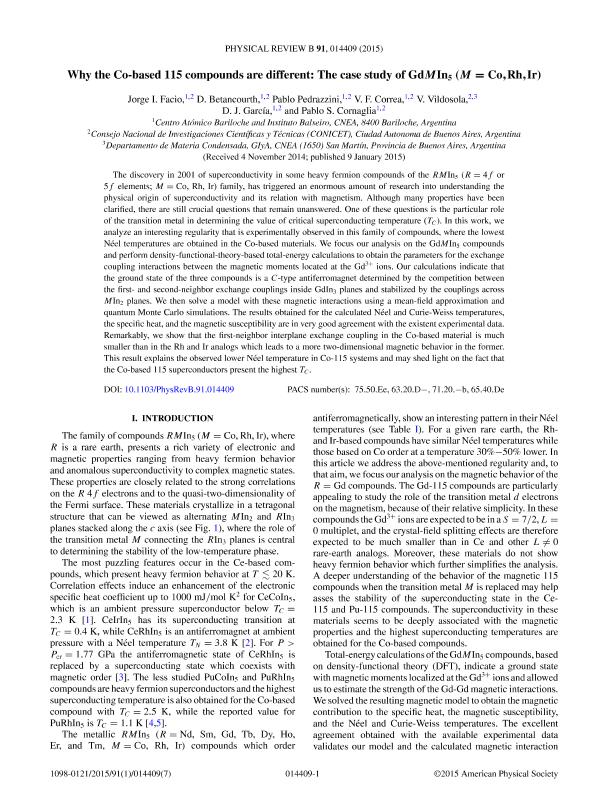Artículo
Why the Co-based 115 compounds are different: The case study of GdM In5 (M=Co,Rh,Ir)
Facio, Jorge Ismael ; Betancourth Giraldo, Diana Maria
; Betancourth Giraldo, Diana Maria ; Pedrazzini, Pablo
; Pedrazzini, Pablo ; Correa, Víctor Félix
; Correa, Víctor Félix ; Vildosola, Veronica Laura
; Vildosola, Veronica Laura ; Garcia, Daniel Julio
; Garcia, Daniel Julio ; Cornaglia de la Cruz, Pablo Sebastian
; Cornaglia de la Cruz, Pablo Sebastian
 ; Betancourth Giraldo, Diana Maria
; Betancourth Giraldo, Diana Maria ; Pedrazzini, Pablo
; Pedrazzini, Pablo ; Correa, Víctor Félix
; Correa, Víctor Félix ; Vildosola, Veronica Laura
; Vildosola, Veronica Laura ; Garcia, Daniel Julio
; Garcia, Daniel Julio ; Cornaglia de la Cruz, Pablo Sebastian
; Cornaglia de la Cruz, Pablo Sebastian
Fecha de publicación:
01/2015
Editorial:
American Physical Society
Revista:
Physical Review B: Condensed Matter and Materials Physics
ISSN:
1098-0121
Idioma:
Inglés
Tipo de recurso:
Artículo publicado
Clasificación temática:
Resumen
The discovery in 2001 of superconductivity in some heavy fermion compounds of the RMIn5 (R=4f or 5f elements; M=Co, Rh, Ir) family, has triggered an enormous amount of research into understanding the physical origin of superconductivity and its relation with magnetism. Although many properties have been clarified, there are still crucial questions that remain unanswered. One of these questions is the particular role of the transition metal in determining the value of critical superconducting temperature (TC). In this work, we analyze an interesting regularity that is experimentally observed in this family of compounds, where the lowest Néel temperatures are obtained in the Co-based materials. We focus our analysis on the GdMIn5 compounds and perform density-functional-theory-based total-energy calculations to obtain the parameters for the exchange coupling interactions between the magnetic moments located at the Gd3+ ions. Our calculations indicate that the ground state of the three compounds is a C-type antiferromagnet determined by the competition between the first- and second-neighbor exchange couplings inside GdIn3 planes and stabilized by the couplings across MIn2 planes. We then solve a model with these magnetic interactions using a mean-field approximation and quantum Monte Carlo simulations. The results obtained for the calculated Néel and Curie-Weiss temperatures, the specific heat, and the magnetic susceptibility are in very good agreement with the existent experimental data. Remarkably, we show that the first-neighbor interplane exchange coupling in the Co-based material is much smaller than in the Rh and Ir analogs which leads to a more two-dimensional magnetic behavior in the former. This result explains the observed lower Néel temperature in Co-115 systems and may shed light on the fact that the Co-based 115 superconductors present the highest TC.
Archivos asociados
Licencia
Identificadores
Colecciones
Articulos(CCT - PATAGONIA NORTE)
Articulos de CTRO.CIENTIFICO TECNOL.CONICET - PATAGONIA NORTE
Articulos de CTRO.CIENTIFICO TECNOL.CONICET - PATAGONIA NORTE
Articulos(SEDE CENTRAL)
Articulos de SEDE CENTRAL
Articulos de SEDE CENTRAL
Citación
Facio, Jorge Ismael; Betancourth Giraldo, Diana Maria; Pedrazzini, Pablo; Correa, Víctor Félix; Vildosola, Veronica Laura; et al.; Why the Co-based 115 compounds are different: The case study of GdM In5 (M=Co,Rh,Ir); American Physical Society; Physical Review B: Condensed Matter and Materials Physics; 91; 1-2015; 144091-144097
Compartir
Altmétricas



